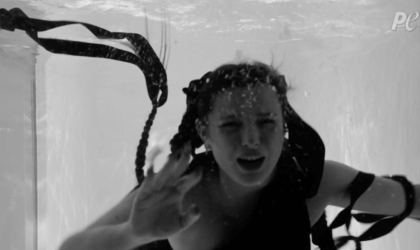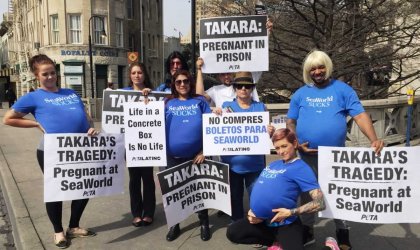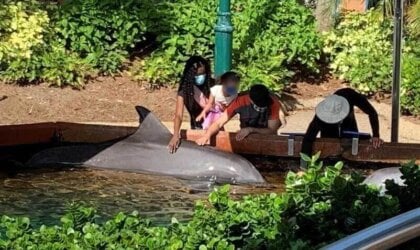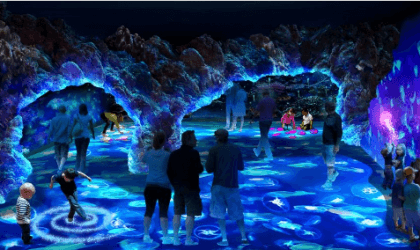In 1980, when he was only about 3 years old, Ulises was abducted from his family off the coast of Iceland and eventually sent to SeaWorld. Now that Kasatka and Tilikum are dead, he is one of the last surviving wild-caught orcas being held captive at the abusement park.
SeaWorld estimates that Ulises is about 39 years old and says that he’s 9,590 pounds and 20 feet long—an upsetting reality, given that the park’s tanks are outrageously small and don’t support natural orca behavior patterns. Although the company boasts that he’s SeaWorld San Diego’s largest killer whale, we know that he has other distinguishing features. Read on to learn more about his heartbreaking story and discover how you can use your voice to help prevent him from enduring the same fate as Kasatka, Kyara, and Tilikum—the three orcas who’ve already died at SeaWorld this year.
‘Life’ at Spain’s Barcelona Zoo
Before becoming a SeaWorld prisoner, Ulises spent 13 years in captivity at the Barcelona Zoo in Spain. While there, he was deprived of the companionship of any member of his own species. Instead, he was imprisoned with bottlenose dolphins who bullied him continually.
In 1992, as he matured and grew larger, reports surfaced that he was acting aggressively and abnormally: mouthing the feet of people in his pool, chewing on his tongue, and chasing a female dolphin in his tank. According to former SeaWorld trainer John Hargrove, Ulises even once grabbed the head of a diver who was cleaning his pool and dragged him to the surface.
In 1994, Ulises was moved to SeaWorld San Diego. Although some reports indicated that he would return to the Barcelona Zoo once a larger tank was built, he remained at SeaWorld.
Incompatibility With Other Orcas
Ulises is submissive to many of the other orcas he’s encountered. He’s sustained injuries and endured stress from being bullied by incompatible tankmates: He’s been bullied by Kalia and “raked” by Kasatka and others in San Diego.
Orcas can't swim away to avoid aggressive attacks by more dominant animals, resulting in injuries. #VetVisitsSW pic.twitter.com/LKEv8KDDnw
— PETA (@peta) August 11, 2015
He’s also aggressive toward and sometimes tries to rake Corky II, the oldest orca at SeaWorld, and he once bit a chunk out of Corky’s tail flukes, resulting in a near-fatal infection. According to Hargrove, Ulises’ aggression toward Corky is so bad that during his time at the park, there was a protocol in place that the two were never to be allowed contact unless Kasatka was also in the environment. Kasatka, who was more dominant, reportedly prevented Ulises from hurting or chasing Corky—but now she’s dead.
Aggression Toward Trainers
Despite being submissive to many of the other orcas, Ulises was considered to be one of the most dangerous ones to interact with in the water when trainers still did so. Only the most experienced trainers were allowed to swim with him. When water-work occurred, he was pushy and exhibited behavior patterns and vocalizations that were known to be precursors to aggression. He has a documented history of aggression toward his trainers at SeaWorld, both in and out of the water.
Learn more about SeaWorld on The PETA Podcast:
Listen to more episodes on iTunes, Stitcher, and Spotify! Subscribe for new episodes.
Ulises isn’t the only orca who became aggressive as a result of the stress that the animals are forced to endure in the small tanks at SeaWorld. The park’s own records contain 600 pages of incident reports documenting dangerous and unanticipated orca behavior with trainers, consisting of more than 100 incidents in which orcas bit, rammed, lunged at, pulled, pinned, or swam aggressively at SeaWorld trainers, many of which led to human injuries, including a near-fatal experience for trainer Ken Peters:
Stress, frustration, and confinement drove Tilikum—the now-deceased orca made famous by the documentary Blackfish—to kill three humans in his lifetime. In 1991, Sealand trainer Keltie Byrne fell into the pool containing three orcas. She was pulled to the bottom of the enclosure by Tilikum, tossed around by all three animals, and ultimately drowned. In 1999, Tilikum killed Daniel Dukes after Dukes reportedly snuck into SeaWorld San Diego and was believed to have entered Tilikum’s pool. In 2010, Tilikum scalped and dismembered SeaWorld trainer Dawn Brancheau, breaking bones throughout her body before drowning her.
During a 2010 #SeaWorld show, a frustrated & confused Tilikum attacked trainer Dawn Brancheau which resulted in her tragic death. pic.twitter.com/8qMCX7CH2Q
— PETA (@peta) November 9, 2016
Aggression toward humans and among orcas is nearly non-existent in nature, but the constant stress of living in incompatible social groupings inside minuscule tanks at SeaWorld causes them to lash out, posing a danger both to other marine animals and to employees.
Other Signs That Captivity Is Devastating
Ulises spends much his time swimming upside down and has been viewed floating listlessly for extended periods of time. Constant deprivation is very stressful and takes a toll on orcas, who frequently display abnormal types of behavior that are never seen in the wild, including directing excessive and even deadly aggression toward humans and other orcas and floating listlessly—both of which Ulises displays.
Breeding
At SeaWorld, trainers would masturbate Ulises to get his sperm, which would then be put in a tube and inserted into female orcas to impregnate them. Male orcas who resisted were removed from the water to make them completely helpless, vulnerable, and unable to swim away or fight back as SeaWorld staff performed the procedure. The video below shows SeaWorld “Killer Whale Trainer” Brian Rokeach holding a plastic bag while grabbing and masturbating an orca’s genitals during a semen collection.
Reportedly, veterinarians had repeatedly said that Ulises wasn’t a viable male and was unable to impregnate a female. However, in 2011, his sperm was used to rape and impregnate Wikie at Marineland in Antibes, France, and his alleged son, Moana, was born. But according to Hargrove, because of Ulises’ low sperm count, the story that he sired Wikie’s calf was crafted to conceal the inbreeding of the female orca with her half-brother, Valentin, who died in 2015 following a flood at the park. This wouldn’t have been the only time that these siblings had been allowed to mate—Keijo, Moana’s younger brother, is also their offspring.
Ulises later mated with Kalia in San Diego, but she was also raped via artificial insemination to ensure that she would become pregnant and gave birth to Amaya. Again, since there’s no independent DNA analysis to prove paternity and veterinarians had asserted that Ulises was infertile, it’s been alleged that Kalia was either artificially inseminated with other semen—possibly Tilikum’s—or that she was inbred with her brother Nakai.
Kalia was only 8 years old when she became pregnant, despite scientific studies showing that in the wild, 14.9 is the average age at which female orcas begin to reproduce. Not only did SeaWorld staffers reportedly observe Ulises mating with the still-developing Kalia and do nothing to prevent it, it’s also especially concerning that they would take steps to rape and impregnate her at such a young age. Becoming pregnant so early in life only increased the chances of complications and death, for both her and her calf, during pregnancy and delivery.
Speak Up for Animals Imprisoned at SeaWorld
An early, miserable death is the fate of captive orcas. It may be too late for Kasatka, Kyara, and Tilikum, but it’s not too late for SeaWorld to start building sea sanctuaries for the other orcas still trapped in its tiny tanks, including Ulises. The decades of orca torment must end now.

You can help Ulises and all the other living beings imprisoned by SeaWorld today. Click the button below to ask the company to end all animal acts at its parks and release the animals into sea sanctuaries.




